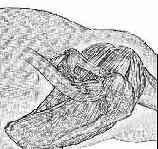 - Discussion:
- Discussion: 
- rotator cuff anatomy
- diff dx of cuff tears (partial rotator cuff tear)
- etilogy of tear
- how do RTC tears heal?
- surgically demonstratable full thickness RTC tears are present in about 1/5 elderly patients;
- MRI studies have been published which note a much higher prevalence of RTC tear;
- prevalence of full-thickness tearing of the rotator cuff ranges from 7% to 40% across multiple studies
- complete supraspinatus tears may occur in up to 20% after age 32 yrs;
- after age 40 years, approximately 30% of patients will have cuff tears, and after age 60 yrs, there will be cuff tears in upto
80% of patients;
- asymptomatic full-thickness tears are present in 13% of the population between age 50-59 and in over 50% of people older
than 80 years old;
- Teefey SA, et al: 100 shoulders in 98 patients with shoulder pain who had undergone preop US and arthroscopy were identified;
- arthroscopic dx was a full-thickness rotator cuff tear in 65 shoulders, a partial-thickness tear in 15, rotator cuff tendinitis in 12,
frozen shoulder in 4, arthrosis of AC joint in 2, and a superior labral tear and calcific bursitis in one shoulder each;
- ultrasonography correctly identified all 65 full-thickness rotator cuff tears (a sensitivity of 100 percent);
- there were seventeen true-negative and three false-positive ultrasonograms (a specificity of 85 percent);
- overall accuracy was 96 percent;
- size of the tear on transverse measurement was correctly predicted in 86 percent of the shoulders with a full-thickness tear;
- ultrasonography detected a tear in ten of fifteen shoulders with a partial-thickness tear that was diagnosed on arthroscopy.
- 5 of 6 dislocations and seven of eleven ruptures of the biceps tendon were identified correctly
- References
Mental Health Has a Stronger Association with Patient-Reported Shoulder Pain and Function Than Tear Size in Patients with
Full-Thickness Rotator Cuff Tears

